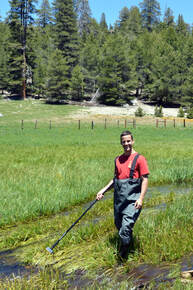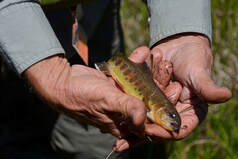 My name is Samuel Zorn, and I am a senior Environmental Engineering student at SDSU. I have been very lucky to be a part of several research laboratories. My first lab was in the biochemistry department under Dr. John Love. We were studying protein design with the intent of using antibodies to halogenate small, organic molecules. My duties involved a lot of bench work which was a great, hands on introduction to the field of biochemistry My current work is with the Disturbance Hydrology Laboratory led by Dr. Alicia Kinoshita. Most of my work has revolved around using satellite and or field data to characterize the resilience and hydrological characteristics of various regions in Southern California. Being a member of the DHL has introduced me to a number of wonderful mentors and peers and has provided me with valuable knowledge that I will continue to apply in my eventual career as an engineer.  Last year I wrapped up a project supported by the San Diego Fly Fishers. The final product was a report about Nine Mile Creek, a small stream in the Southeastern Sierra Nevada, California, which is home to wild hybridizations of golden and rainbow trout (Oncorhynchus Aguabonita & Oncorhynchusmykiss). This report focuses on the condition of Nine Mile Creek in Casa Vieja Meadow from 1995 - present. Observations of erosion and undercutting provide direction for developing a plan for future data collection to further describe Nine Mile Creek habitat and ensure that their habitat is protected. Research was conducted using a combination of satellite and field data composed of Google Earth imagery, United States Geological Survey data, and data points collected in the field with a global positioning system (GPS) receiver that records longitude, latitude, and elevation data. Findings indicated that for the 1.17 kilometers of creek analyzed, there have been no significant changes to stream meander over the past 25 years. However, some specific areas of the stream showed evidence of undercutting and potential erosion. These locations require further monitoring to assess the rate of geomorphological change. The report also identifies topics that should be explored further, such as the effects of cattle grazing and the absence of woody plants on erosion, sediment, and trout habitat.
0 Comments
Leave a Reply. |
About the authorsFollow the adventures and reflections from the DHL undergraduate student interns and research assistants! Archives
June 2022
Categories
All
|

 RSS Feed
RSS Feed
